Montessori, why not?
I chose a Montessori school for my son almost as an act of faith. At that time my knowledge of the method was zero; I had only heard of small chairs and colored beads. But seeing my son happy day after day encouraged me to make a thorough study of Montessori’s ideas. What I discovered astonished me both as a father and a scientist. As a father, I found that children are really respected and prepared for the future. As a scientist, I found solid scientific foundations for everything Maria Montessori proposed.
And now that my son has completed his Montessori experience, I would like to present concrete examples gathered during those years, hoping to convince other parents that their fears and concerns are unfounded and that sending their children to a Montessori school is the best present they can give them.
With a huge thank you to Carolina Montessori for correcting my uncountable English blunders and for clarifying the words of her great-grandmother.
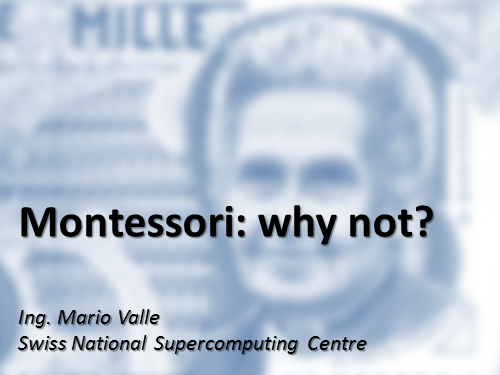
Good morning and thanks for the invitation!
I’m a Montessori father and I’m here today to share with you the reasons why I sent my son to a Montessori school and why I’m convinced this has been the best present I have ever given him.
In the first place I must confess that my knowledge of Montessori was almost zero; until a few years ago…

…practically all I knew about Maria Montessori was her image on the now obsolete Italian thousand lire banknote.
But before explaining how and why I moved from total ignorance to speaking here on Montessori's ideas, let me tell you a story.

The story begins when my son Nicolò, almost 3 years old, had to be enrolled in kindergarten.
My wife and I agreed to take the most obvious choice, …

…which was the public kindergarten at a two-minute walk from our house. So far so good. But, …

…after a few weeks, our son began to cry and didn’t want to go to school anymore. Worse, I saw his enthusiasm and energy diminishing day by day.
At the beginning, we were convinced these were tantrums and thought: “He will change, he will get accustomed to the new environment…” and so on.
Unfortunately, after a few months we discovered that his teacher was absolutely incapable of working with children, had literally destroyed my son’s self-esteem and, even worse, did not respect his needs as a child.
After the umpteenth humiliation we took him out of the kindergarten, convinced that any other choice would be better than this.
Soon we started searching for another school. At this point we were not interested at all in the pedagogical method. We wanted a school in which our son would be respected as a person.
One day my wife said: “I heard there is a Montessori school ten kilometers from our home. I remember from my studies (she is a teacher) that respect for the child is the first and foremost principle.” OK, let’s go and see.

We were so amazed by what we saw: the order, the smiling children, the silence… that we instantly decided to enroll Nicolò there.
For me this decision was an act of faith, because, as I said earlier, for me Montessori meant small tables and chairs, nothing more. For my wife it was even worse, because she is a traditional school teacher who in this way “betrayed” the career she had chosen. But the decision proved to be right, because almost immediately …

… Nicolò began to flourish! We regained the child we used to know.

After the Children’s House, the next logical step was to send him to a Montessori primary school. Almost every day he returned home with incredible stories, …

…telling us: “Today I «played» with mathematics”, or…

… “Today I discovered this and that”. …

…And we heard the same stories from the parents of his classmates.
In short, he painted a picture of his school life which was completely different from my own. For me, school had been a neutral place where I went, did things, sat still, and only when I came home I could do things that really interested me. Instead…

…Nicolò was happy to go to school, learned a lot and, most importantly, regained his self-confidence.
(He asked me to include this slide: “Here is the happy face of every Montessori student.” It is so very true).

Well, I could just stop here. The story I presented, and many other similar stories, should convince you that Montessori is the best present you can give your sons and daughters and that you can trust Montessori, even if you don’t understand exactly what it is all about.
Don’t worry, I won’t stop here because at this point I was happy but not satisfied, …

… because I’m a scientist who works at the Swiss National Supercomputing Centre in Lugano where some of the most powerful …

…supercomputers of the world are hosted. Piz Daint, for example, which today (July 2016) is the eighth most powerful computer in the world and the most powerful in Europe. …

… And at CSCS I work very often with renowned scientists.
A scientist wants to understand why. Why is this school so different from traditional schools? Does it depend on the school fees, or on the teachers? Or on the area where the school is located or what? So I started collecting data and fragments of ideas, but I soon realized …

… that my son was pushing me into an unknown territory where there are more questions than answers. Why are these students so happy and so concentrated? How can colored pearls teach arithmetic? Why do they work without computers? So …

…I started to attend all the presentations organized for parents,…
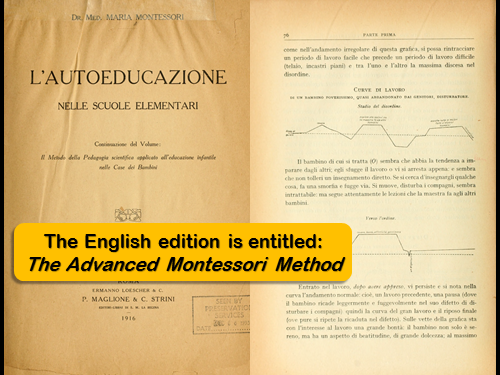
… to read books, especially the ones by Maria Montessori, to visit sites of Montessori schools — there are plenty of them on the web — and, more importantly, to ask my questions to the school’s pedagogical expert …
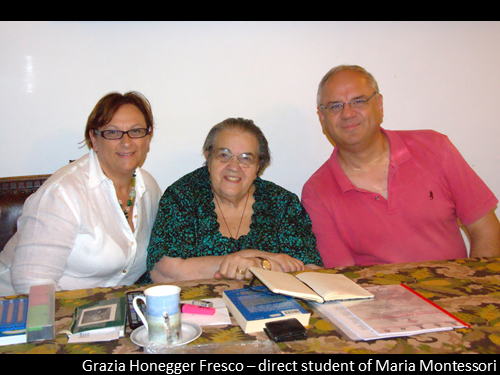
… Grazia Honegger Fresco, who, as I soon discovered, is one of the last living students of Maria Montessori.

Here is a photo of Grazia at age twenty attending the Montessori International Congress in 1949.
Apart from Grazia, I have had the honor to meet wonderful women who studied under a direct student of Maria Montessori: Luana Gigliarelli and the other teachers in Perugia studied under Maria Antonietta Paolini, Donatella Pecori was a student of Flaminia Guidi, while Costanza Buttafava was trained by Giuliana Sorge. Extraordinary people who have shown me, without words but by how they lived, what it means to have absorbed Montessori’s spirit and ideas. Unfortunately, I have also met teachers who have Montessori only on their diploma. Poor children!

By the way, Grazia herself suggested the title for this presentation. She has written a book entitled “Montessori: perché no?” [Montessori: why not?], full of interesting documents and testimonies.
Now that you have heard my story with its “happy ending”, I would like to share with you the results of my scientific investigations, which have convinced me that Montessori is the best educational idea ever.

First reason: Maria Montessori was a scientist, a real experimental scientist …

… who explored the child’s mind by observing him, not by putting forth a theory and then distorting the facts to match it. No, she observed, experimented with the materials, pondered what she had seen and only then drew conclusions. By doing so, all her ideas were rooted in reality, as all science should be. Yes, it is true that there are no tables of data, statistical tests or charts in her books, but the scientific basis of her ideas is there, although written in words and not in numbers. …

…But don’t forget that she said “I just started the work”, so at present…

…there are quite a few scientists who are studying Montessori’s ideas with the tools of today. For example, Angeline Lillard …
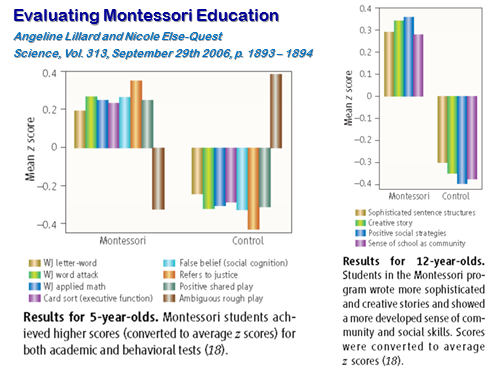
… has validated what Montessori saw 100 years ago, …
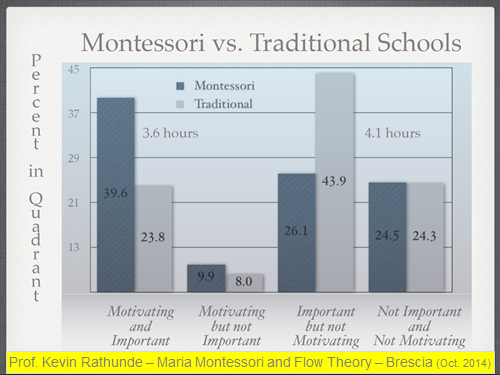
… or Professor Kevin Rathunde who is studying concentration in a Montessori school, …

… or Donatella Pecori in Italy who has studied normalization using high speed cameras, producing impressive charts that confirm exactly what Montessori wrote in her books in the language of the early 20th century.

What really convinced me as a scientist was the perfect match between Montessori's ideas and the function of the brain.
At the end of a talk in Carpi (Modena), a participant approached me, telling me that he worked in the rehabilitation of people with serious neurological problems. He said: “After all the courses that I have followed on the human neural system and brain functioning, I can say that Montessori works because that’s how the brain works.”
Yes, “Montessori works because that’s how the brain works” is a strong reason to choose Montessori education. Now I want to show you just a few examples of this correlation, because an entire lecture is not sufficient to cover everything.

First example. What you see here is quite common in a Montessori school. Instead, in a traditional school the teacher would certainly yell: “Return to your desk! You are wasting time and disturbing another child!”
But the girl who is watching here is working hard as confirmed by a recent neurophysiological discovery: …

…the mirror neurons. They are motor neurons that are activated when we perform an action, but also when we watch the same action done by others. This means that when we watch an action we are really simulating the same action internally. …

… Here the boy dressed in yellow is actually working and learning merely by watching other children work.

When a teacher presents a material, she breaks the action down and shows one step at the time slowly and precisely (which Montessori calls analysis of movement), to facilitate the work of mirror neurons to capture and acquire a new movement.

Why do children carry the “long rods” this way? Wouldn’t it be much easier to pick up a rod in the middle with one hand as though carrying a suitcase? But in this way their muscles and their minds learn the length of one meter, because…

… there is a hierarchy in our perceptual system in acquiring quantitative measures. And length is one of the most accurate. Volume, that is the weight that you perceive when carrying the rod with only one hand, is much less accurate. For me this is another very true insight of Maria Montessori.

Here is another example. Children learn to put numbers on a mental line that for Westerners goes from left to right. But the numbers are not uniformly distributed. The bigger ones are more compressed, whereas there is more space between the smaller numbers. The authors of this study discovered that …

… the more children were able to make this line uniform, the better they were able to remember numbers. And what do you see in a Montessori school? …

… Children putting labels on the “thousand chain” exactly in reverse order with respect to the mental line: more concentrated at the beginning, less at the end. In a certain sense this compensates for the differences in the density of the numbers, making the mental line more uniform. Is it just a coincidence? I don’t think so.

What about the classrooms with such bare walls, so common in a Montessori school? There is no need for scientific research to understand that less visual distractions improve the child's concentration. …

… People who visit a Montessori school for the first time are amazed by the concentration. They see children completely immersed in what they are doing, …

… a condition actively encouraged by teachers and summarized as follows in the writings of Maria Montessori: “The first premise for the child’s development is concentration. The child who concentrates is immensely happy.”

The same results were found a few years ago by Professor Mihály Csíkszentmihályi who studied this condition of deep concentration, which he calls “flow”, as well as the conditions needed to enter flow and the results and benefits.

Recently, one of Csíkszentmihályi's students began to study flow in Montessori schools and has written some very interesting articles. Apart from the content of the article I am referring to, I found two interesting statements: first, he says that he does not belong to the Montessori community, so his conclusions are not influenced by preconceived ideas (every scientist should do this). Second, he states that Montessori's ideas on concentration deserve to be studied much deeper because it is a hot topic in current psychological research.

Interesting, but what are the conditions to enter into flow? In the first place, you need clear rules. And what do you find in a Montessori school? Clear rules!

In the second place, you need immediate and clear feedback on where you are in a chosen job. And this is exactly what the material provides. For example, when stringing beads the length of the string is exactly what is needed for the task: the child can see at a glance where he is in his work.

But the most important condition to enter into flow is that the challenge, the difficulty of the task (the red dots), should be equal to or just a little above the person’s skills.

In this way the person enters flow and stays in the so called “flow channel”, because …

…if the task is too simple it is boring (1). If it is too complex with regard to the person’s skills, it generates anxiety (2). The correct balance however induces flow (3).
We find the exact same concept in the work of Vygotskij who called it instead the Zone of Proximal Development, the area in which “optimal frustration” allows the child to concentrate and learn. [Thank you, Davide Tamagnini!]

And what happens in a Montessori school? The teacher suggests an activity, sees it is too simple because the child is getting bored, so she proposes another one that is a bit too complex. Finally, she suggests another activity that corresponds to the child's interests and skills. He can now concentrate on this activity and enter the flow channel and thus become “immensely happy”.

How does the teacher arrive at this result? By carefully observing each child. Here the teacher acts as a scientist, testing out hypotheses about what kind of assistance might be most helpful to this particular child or if he is ready for new challenges. It is not easy to do. It takes training to become a scientist.

Another example is provided by the Executive Functions. These are a set of mental functions that help us manage new and unexpected situations. The most important functions are: self-control, working memory, cognitive flexibility, plus other, more complex ones: planning, reasoning, problem-solving.
Adele Diamond, a renowned neuroscientist, has published a study in Science comparing various educational methods in terms of how they help the development of Executive Functions. Needless to say, Montessori comes through with flying colors because it provides many activities especially targeted to the development of Executive Functions. For example: the limitation of materials, the silence game, walking on the line, math activities, memory games, all practical life exercises, and many, many more.

These few examples should convince you, just as they convinced me, that “Montessori works because that’s how the brain works.” And this fact alone makes me happy to have chosen a Montessori school. But listen to the sense of wonder that permeates the words of an expert: …

…Dr. Steven Hughes, President of the American Academy of Pediatric Neuropsychology and Chair of the AMI Global Research Committee, said in an interview: “Maria Montessori really got everything right … She anticipated so much of what we know about neuroscience, brain development, and optimum models of education.”
But in my view there is a much more important reason to choose Montessori. …

… In the words of Maria Montessori: “Children are human beings to whom respect is due, superior to us by reason of their innocence and the greater possibilities of their future.” This respect comes before the materials, before the school routine, before the presentations. It is respecting the pace of the child, his aspirations and desires by guiding, not drilling, him. This is the reason why Montessori’s ideas are more relevant than the techniques.

I found all this aptly summarized in what a parent once told me: “Montessori is an attitude, not a type of school.”

Yes, the parents. They — as I once did — have doubts as they often don’t understand what happens in a Montessori school. As a parent, I have tried to help my colleagues and discovered an interesting fact: all parents have exactly the same concerns. …

…Some of these I have collected and, with the help of Grazia Honegger Fresco, I have tried to answer them. You can find this collection on my website in Italian and English. But here I will try to cover the most popular ones.

First concern: What will happen after the Montessori school?

Nothing.
My son actually profited the first two years in secondary school from the preparation given him by the Montessori school.
Nothing happens, because the children have been guided to exercise responsible free choice since early childhood and so they are stronger and more aware of their environment. They have acquired a sense of responsibility in the way they work and interact with others, the ability to control themselves, to reason and cooperate.
Moreover, in the last year of primary Montessori school the teachers try to prepare the children to cope with the new, different environment that awaits them: the system of grades, competitions, tests and especially the absence of choice. To achieve this, it is essential in a Montessori school to strengthen the children, making them live in a non-anxiety-provoking, non-judgmental and non-competitive environment at least in the early years.

Second concern: Does a Montessori school produce children who do not live in the real world? And related to this the following “brilliant” idea: I think children need the competitiveness and frustrations they will find in the world that awaits them.

As a Montessori teacher once said: “«Public school is the real world» is one of the most ignorant things I have ever heard. It’s real if you’re gonna work in a cubicle for the rest of your life, that’s about it.” The real “Real Life” needs other skills: cooperation, creativity, imagination, communication. Not frustration. If you want to see where that “brilliant” idea takes you and if you want to become depressed by the sore status of education (at least in the USA) read …

…the article by Alfie Kohn entitled: “Getting Hit on the Head Lessons”.

The title comes from an old Monty Python sketch in which the teacher hits the student's head with a big hammer. When the student recoils and cries out, the instructor says: “No, no, no. Hold your head like this, then go, ‘Waaah!’ Let's try again.” — and gives him another smack. This is exactly what people do who ask for more frustration at school!
The theme of the article was precisely this: politicians and planners justify bad educational practices as a preparation for more of the same.

Another concern: Montessori is antiquated and does not use new technologies. Its materials are not abreast of the times, they are old and do not evolve.
Before answering this concern, ask yourself the real, fundamental question: what do we want our children to become? Do we want button-pushers who use technology, but don’t understand it?

Moreover you should realize that a tablet in the classroom does not make a school digital. An interactive whiteboard in a classroom does not make a school modern when it is only used for traditional lessons. Do you realize that the developers of the latest smartphone applications use paper, pens and Post-it to design them? It’s not the technology that makes a school modern, but the ideas and principles the school embodies.

For example, at my son’s school there was a computer, but the children queued up to use this old mechanical typewriter. Why? Maybe because they can see what happens, when they push a key. Again it is not technology that matters, but what satisfies their curiosity.

My colleague John has never seen an actual Francis turbine like this one. Yet he had to imagine it and manipulate it in his mind to find the best way to represent the movement of water in order to help the scientists understand where and how vortexes are formed in the turbine’s drain conduit.

In my visualization of chemical data I can only manipulate representations of molecules behind a glass screen, the monitor of my computer. It is obvious that I still need to be able to handle these objects and models in my mind in order to obtain effective manipulations.

In both cases we are able to manipulate objects in the mind if we are able to manipulate physical objects in a real environment. And what could be better for acquiring this capacity than the “puzzle maps” in a Montessori school? And there is a reason why this works.

The famous psychological test by Shepard and Metzler shows that we rotate mental representations as if they were physical objects. How did they reach this understanding? The test consists of finding which item at the bottom row corresponds to the one at the top. The time it takes to determine which two objects match is proportional to the angle that exists between them. That is, we rotate in the brain one object to match the other as if they were physical objects. (In the problem shown here, the object at the top corresponds to object B).

Very simple technology, but the child learns how to formulate the right questions. As we all know, today it is simpler to obtain answers than to pose interesting questions.
This is another example that shows how Montessori schools prepare children for the future by focusing on skills that really matter.

Another concern: Do children do whatever they want in a Montessori school?
Let's be clear: the willingness of the child to be active and to work hard is closely related to the possibility of choosing freely from the many things on display in the environment, without the adult telling him what to do.

In addition, along with free choice, the child also takes responsibility for the use of the materials. These should be handled with care, they should be put back in the right place when the child has finished his work and should be used appropriately. Few rules, but rigorously followed in a responsible way.
This responsibility is not just the “do what I want” in the usual, ambiguous and arrogant sense of the phrase.

A Montessori student once said: “Here we do not do what we want, we want what we do!” A nice and clear summary.

The last concern is perhaps a misplaced expectation: will a Montessori school make my son a genius? Could be, but this is not the goal of the school because, …

… as Maria Montessori said, and has been recorded in the AMI statutes: “The primary goal of Montessori education is to prepare the whole child to reach his full potential in all areas of life.”

Even famous Montessorians put the focus in the right place. One of them, video game pioneer Will Wright, said Montessori was the “imagination amplifier” that prepared him for creating The Sims, Sim City, Spore and Super Mario Brothers. “Sim City comes right out of Montessori… It’s all about learning on your own terms.”

I hope that with these replies I have succeeded in dispelling the concerns of the parents (and the teachers). I bet your first question will be: “What can I do to know more about this Montessori world?”

First of all, observe. Go to a Montessori school and see what they do, just as these mothers did from the garden fence of one of the early Montessori Children’s House. Ask if you may visit the school and observe, without disturbing or speaking.

Exchange experiences with other parents. I found it very interesting to read this book that relates the experience of a father who, after various problems, ended up by finding a Montessori school.

On the internet you can find a short movie based on the book which presents Montessori's main ideas.
What else can you do?

Go to the presentations of the materials or various aspects of Montessori organized for parents. In Brescia (Italy) the local association has even organized a “School for Parents”.

If you decide to enroll your child in a Montessori school, discreetly find out if the teachers are capable, just as the Secret Service does when you apply for a classified position! Your child is much more valuable than a “Top Secret” dossier. If the teachers have not absorbed Montessori, they could wreak havoc on your child's development. I don’t speak of technical experience, I speak of their ability to put the child at the center.

And, last but not least, the atmosphere at home. If the child is not respected at home as he is at school, half of the advantages of a Montessori education vanish. I’m not speaking of big issues or shameful situations. It's about cutting the meat on your child’s plate when he wants to do it himself just as he does at school.

Is it clear?
As I said before, “Montessori is an attitude, not a type of school.” Because it is “simply” revolutionizing the relationship between adult and child. Nothing less. And good, well prepared teachers will help and guide this revolution with the cooperation of you, the parents.

Now we are ready to finish. I hope to have succeeded in transmitting at least part of my enthusiasm in a way that urges you to …

… change the question “Montessori: why not?” into a…

…resounding “Montessori: yes!” Because this is the best present you can give to your sons and daughters. And to yourself.

Thank you so much for your kind attention!
Useful references
| Angeline Lillard’s — “Montessori: The Science behind the Genius” | www.montessori-science.org |
| The Montessori FAQ | mariovalle.name/montessori/faq-en.html |
| Alfie Kohn — Getting Hit on the Head Lessons | www.alfiekohn.org/article/getting-hit-head-lessons |
| Montessori Madness | montessorimadness.com |
| Montessori Madness — The Movie | www.youtube.com/watch?v=GcgN0lEh5IA |
| Adele Diamond research | www.devcogneuro.com |
| Kevin Rathunde paper: “Montessori education and optimal experience: a framework for new research” | www.montessori-namta.org/PDF/rathundeframework.pdf |
| Clarissa A. Thompson and Robert S. Siegler. Linear Numerical-Magnitude Representations Aid Children’s Memory for Numbers. Psychological Science, 2010; DOI: 10.1177/0956797610378309 | Public copy. A summary can be found on: www.sciencedaily.com/releases/2010/09/100909114121.htm (Child’s “Mental Number Line” Affects Memory for Numbers) |
| Angeline Lillard and Nicole Else-Quest, Evaluating Montessori Education, Science, Vol. 313, September 29th 2006, p. 1893–1894 | Local copy |
| Swiss National Supercomputing Centre (CSCS) | www.cscs.ch |
| Return to the Montessori resources (English) | Go back |
License
This work by Mario Valle is licensed under Creative Commons License Attribution, Non Commercial, Share Alike 4.0 International (CC BY-NC-SA 4.0)
You are free to:
- Share — copy and redistribute the material in any medium or format.
- Adapt — remix, transform, and build upon the material.
Under the following terms:
- Attribution — You must give appropriate credit, provide a link to the license, and indicate if changes were made. You may do so in any reasonable manner, but not in any way that suggests the licensor endorses you or your use.
- Non Commercial — You may not use the material for commercial purposes.
- Share Alike — If you remix, transform, or build upon the material, you must distribute your contributions under the same license as the original.
This is a human-readable summary of (and not a substitute for) the license. More information can be found at: creativecommons.org/licenses/by-nc-sa/4.0/